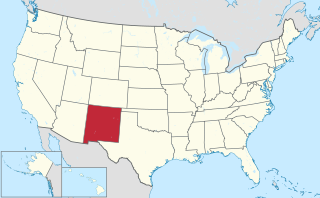
Bank of the West Tower is a highrise office building in Albuquerque, New Mexico. It is located on Central Avenue some 3.5 mi (5.6 km) east of Downtown. At 64.9 m (213 ft), the 17-story tower was the tallest building in New Mexico when completed in 1963. It is now the fifth tallest building in the state, and the tallest outside of Downtown Albuquerque. The building was developed by the Del Webb Corporation and designed by the architectural firm of Flatow, Moore, Bryan, and Fairburn. For most of its history the tower housed a succession of bank branches.

The Sunshine Building is a historic six-story building in downtown Albuquerque, New Mexico. It was built in 1924 by local theater owner Joseph Barnett and houses the Sunshine Theater as well as commercial space and offices. The Sunshine operated primarily as a movie theater until the 1980s, though it was also equipped for Vaudeville shows and other live performances. Since 1990 it has operated as a live music venue, hosting many notable acts. The building was listed on the New Mexico State Register of Cultural Properties in 1985 and is also an Albuquerque City Landmark.

The old Albuquerque High School is the former home of Albuquerque High School. It is located in East Downtown Albuquerque, New Mexico and is protected by the city as a historic landmark. It is located on the northeast corner of Central and Broadway NE, at the center of an area that has become known as East Downtown or EDo. The campus comprises five buildings, the oldest of which was built in 1914. After the school moved to a new location in 1974, the old buildings were left abandoned for decades before being renovated as loft apartments in the early 21st century. Old Albuquerque High was added to the New Mexico State Register of Cultural Properties in 1977.

The Occidental Life Building is a historic office building in Albuquerque, New Mexico, in the United States. Featuring an unusual Venetian Gothic Revival architectural style inspired by the Doge's Palace in Venice, the building is one of the city's most recognizable landmarks and has been described as "unique in the country".

The Southwestern Brewery and Ice Company is a historic brewery in Albuquerque, New Mexico, located adjacent to the BNSF railroad tracks in East Downtown. Built in 1899, it is one of the only surviving 19th-century commercial buildings in the downtown area.

Jones Motor Company is a historic U.S. Route 66-era building in Albuquerque, New Mexico. Built in 1939, on Central Avenue in the Nob Hill neighborhood of Albuquerque, the building originally housed Ralph Jones' service station and Ford Motor Company car dealership. It was designed by Tom Danahy in the Streamline Moderne style, with curved garage bays surmounted by a central stepped tower.
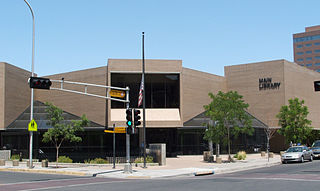
The Albuquerque Bernalillo County Library is the public library system serving greater Albuquerque, New Mexico. It includes seventeen branch libraries as well as the downtown Main Library.

The First National Bank Building is a historic building in downtown Albuquerque, New Mexico, and the former headquarters of the First National Bank of Albuquerque. The nine-story building was completed in 1923 and was considered the city's first skyscraper with an overall height of 141 feet (43 m). It remained the tallest building in the city until 1954, when it was surpassed by the Simms Building.

Castle Apartments was a historic apartment building in Albuquerque, New Mexico, United States, which was destroyed by fire in 2009. It was located on the southeast corner of 15th Street and Central Avenue, roughly halfway between Downtown and Old Town, and took its name from the Huning Castle mansion, which originally stood on the other side of 15th Street.
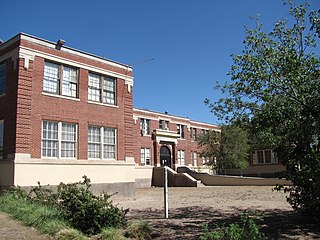
The Harwood School is a historic building in Albuquerque, New Mexico, which was originally a Methodist boarding school. Built in 1925, it is a two-story, H-shaped building with a red brick facade and Neoclassical detailing. The building ceased operating as a school in 1976 and now houses a community art center as part of the outreach programs of Escuela del Sol Montessori. It was listed on the New Mexico State Register of Cultural Properties in 1979 and the National Register of Historic Places in 1980.

The Werner–Gilchrist House was a historic house located in the University Heights neighborhood of Albuquerque, New Mexico. Built in 1908 as one of the earliest structures on the East Mesa, it was considered a pioneering building in Albuquerque's 20th-century suburban growth. It was added to the New Mexico State Register of Cultural Properties and the National Register of Historic Places in 1982. After standing empty for decades and reaching an advanced state of disrepair, the house was finally demolished in November 2011.

Coronado School is a historic elementary school in the Barelas neighborhood of Albuquerque, New Mexico. Built in 1936–37 as a Public Works Administration project, it is the city's third-oldest operating elementary school. Coronado School was added to the New Mexico State Register of Cultural Properties and the National Register of Historic Places in 1996.

The Southern Union Gas Company Building is a historic building in downtown Albuquerque, New Mexico, which is notable as one of the earliest International style buildings in the city. Built in 1951, it was the largest of several Southern Union offices around the state designed by southwestern architect John Gaw Meem. Meem was much better known for working in the Pueblo Revival style but did design a handful of other modernist buildings, such as the Colorado Springs Fine Arts Center.
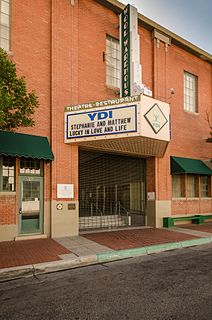
The Wool Warehouse is a historic building in the Warehouse District of downtown Albuquerque, New Mexico. Built in 1928–29 by wool merchant Frank Bond, the warehouse is significant for its role in New Mexico's wool industry in the mid-20th century. It was added to the New Mexico State Register of Cultural Properties in 1980 and the National Register of Historic Places in 1981.
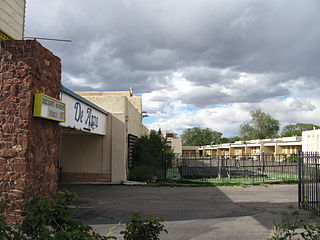
The De Anza Motor Lodge was a historic motel located on former U.S. Route 66 in the Upper Nob Hill neighborhood of Albuquerque, New Mexico. It was built in 1939 by Charles G. Wallace, a local trader of Zuni art and pottery, who remained the owner until 1983. Wallace decorated the motel with a variety of Native American art, including a series of murals by Zuni artist Tony Edaakie in a basement room.

The McCanna–Hubbell Building, also known as the AG&E Building, is a historic commercial building in downtown Albuquerque, New Mexico. Built in 1915, it is a two-story brick structure with a prominent cornice. From 1917 to the mid-1960s the building was the headquarters of the Albuquerque Gas & Electric Company, which later became the Public Service Company of New Mexico (PNM). During this period the piers and cornice of the building were decorated with hundreds of electric light bulbs, the sockets for which are still in place. PNM later moved two blocks south to the PNM Building on Silver Avenue.

The Art Annex is a historic building on the campus of the University of New Mexico in Albuquerque, New Mexico. Built in 1926, it originally served as the university's library. The building was designed by Trost & Trost and Elson H. Norris and features a Mayan-influenced hybrid form of Pueblo Revival architecture. It was listed in the New Mexico State Register of Cultural Properties in 1975 and the National Register of Historic Places in 1988.

The S. H. Kress Building is a historic commercial building in downtown Albuquerque, New Mexico. Built in 1925 by the S. H. Kress & Co. department store chain, it is notable as a well-preserved early 20th century retail building. It was added to the New Mexico State Register of Cultural Properties and the National Register of Historic Places in 1984.

The Pacific Building, also known as the Pacific Desk Building, is a historic building in Albuquerque, New Mexico. Built in 1914, it is notable as a well-preserved example of early 20th-century commercial architecture in Downtown Albuquerque and includes one of the only remaining cast iron storefronts in the central business district. The building was added to the New Mexico State Register of Cultural Properties and the National Register of Historic Places in 1980.

The Berthold Spitz House is a historic house in Albuquerque, New Mexico, which is significant as the city's best example of Prairie School architecture. It was built around 1910 by Berthold Spitz, a German Jewish merchant who was born in Bohemia and immigrated to Albuquerque around 1880. Spitz ran a successful dry goods business and made a few forays into local politics before being appointed as the city's postmaster in 1921. The house was designed by Henry C. Trost of the El Paso firm of Trost & Trost. It was listed on the New Mexico State Register of Cultural Properties in 1975 and the National Register of Historic Places in 1977.



